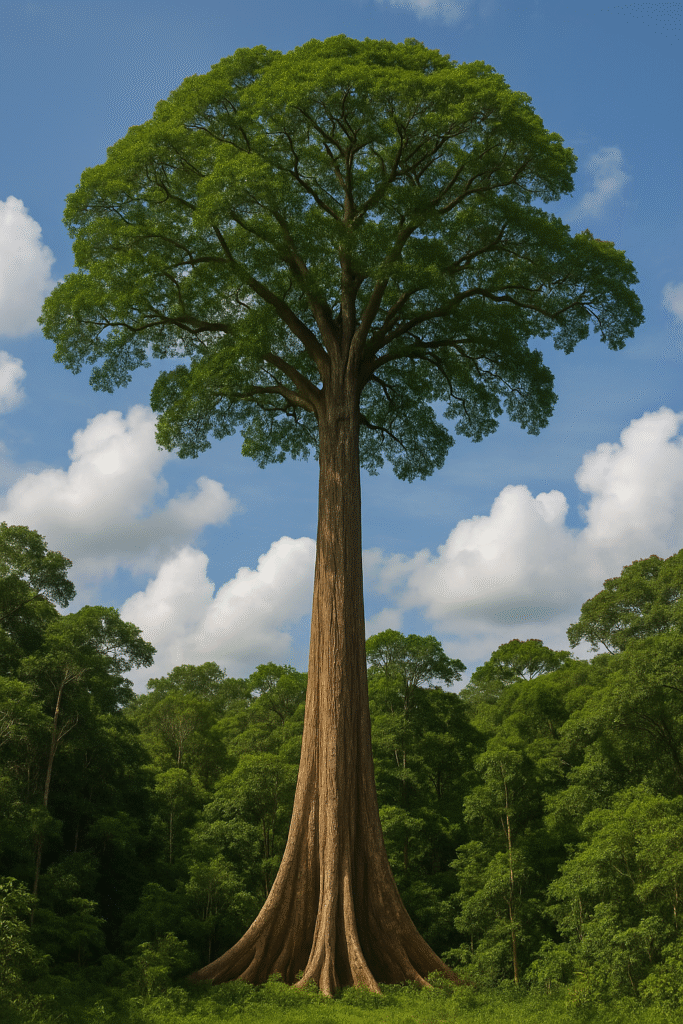The jequitibá-rosa (Cariniana legalis) is one of the most majestic trees in Brazil and a living symbol of the grandeur of the Atlantic Forest. Reaching heights over 50 meters (165 feet) and trunk diameters of more than 3 meters (10 feet), the jequitibá-rosa is considered one of the tallest native trees in South America — and also one of the oldest, with some specimens living for over a thousand years. In this article, you’ll learn about its characteristics, ecological importance, cultural significance, and the urgent need for its preservation.
Origin and distribution
The jequitibá-rosa is a tree endemic to Brazil, meaning it occurs naturally only within Brazilian territory. Its original range includes the southeastern and southern states, especially São Paulo, Minas Gerais, Rio de Janeiro, Espírito Santo, and parts of Paraná.
As a typical Atlantic Forest species, it thrives in humid climates and well-drained soils. However, due to heavy deforestation over the centuries, very few ancient specimens remain. Some of the oldest jequitibás can now be found in conservation areas and state parks.
Key features
The jequitibá-rosa is renowned for its monumental size. Here are its main characteristics:
- Height: Often exceeds 50 meters (165 ft), with common specimens between 30 and 40 meters.
- Trunk diameter: Can surpass 3 meters (10 ft).
- Bark: Thick, grayish, with deep vertical grooves.
- Leaves: Simple, alternate, with smooth edges.
- Flowers: Small and white, blooming between September and November.
- Fruits: Woody capsules that open when ripe, releasing winged seeds.
This species is deciduous, shedding its leaves during the dry season to conserve water.
Ecological importance
The jequitibá-rosa plays a crucial role in the health and diversity of the Atlantic Forest ecosystem:
1. Habitat for wildlife
Its dense canopy offers shade, shelter, and nesting spots for birds, mammals, and insects. Trunk cavities are commonly used by animals such as owls, marmosets, and even jaguars in some regions.
2. Seed dispersal
Birds and small mammals feed on its fruits and help disperse its seeds, promoting regeneration in the forest.
3. Climate regulation
Thanks to its massive size, this tree captures large amounts of carbon dioxide, helping fight climate change and regulate local microclimates.
Cultural and historical value
Beyond its environmental role, the jequitibá-rosa holds deep cultural significance for Brazilians. Many Indigenous peoples view it as a sacred tree, while rural communities often regard it as a forest guardian.
Some famous specimens, such as the Jequitibá-Rosa of Santa Rita do Passa Quatro (SP), have names and receive visitors. That specific tree is estimated to be over 3,000 years old, making it one of the oldest living beings in Brazil.
Threats and conservation
Unfortunately, the jequitibá-rosa is listed among Brazil’s threatened species, due to:
- Deforestation of the Atlantic Forest
- Illegal logging
- Urban and agricultural expansion
Its wood is highly valuable but protected by law — harvesting is strictly prohibited. Even so, illegal cutting still occurs in remote areas.
Conservation efforts include:
- Reforestation projects
- Creation of Protected Areas and Reserves
- Environmental education campaigns
- Mapping and monitoring of monumental trees
Additionally, the jequitibá-rosa is being planted in restoration programs and ecological landscaping, helping reintroduce it to degraded environments.
How to recognize a jequitibá-rosa
When walking through forest trails or visiting conservation parks in Brazil, you might spot a jequitibá-rosa if you see:
- A very tall and straight trunk, often with buttress roots (wide roots at the base)
- A trunk that towers over the surrounding forest
- A dense, rounded crown of leaves at the top
- Wildlife activity in and around the tree
Some institutions allow the public to report giant trees they find, contributing to the mapping of these living monuments.
Final thoughts
The jequitibá-rosa is much more than a tree — it is a living monument and a symbol of Brazil’s natural heritage. Protecting it means preserving the history, biodiversity, and spirit of the Atlantic Forest.
By learning more about this green giant, we become more aware of the urgent need to conserve our unique ecosystems. The jequitibá-rosa teaches us resilience, longevity, and the value of standing tall in the face of time — as long as we give nature a chance to thrive.

Light up every adventure with the LHKNL Headlamp Flashlight. Ultra-bright, lightweight, and rechargeable, this 2-pack offers white & red light, waterproof design, motion sensor, and 8 versatile modes — perfect for camping, hiking, running, or fishing.
Get Your Headlamp SetDiscover the Guapuruvu — a majestic Brazilian tree known for its rapid growth and golden blooms. Learn its history, benefits, and how it brightens landscapes.
Read the Guapuruvu Guide
